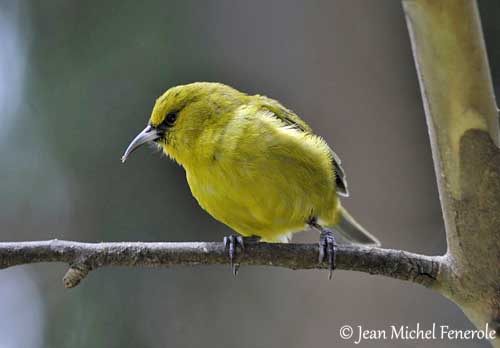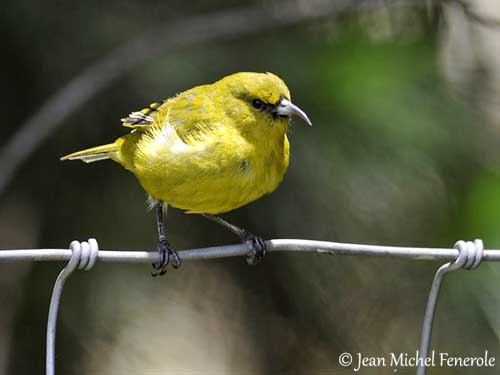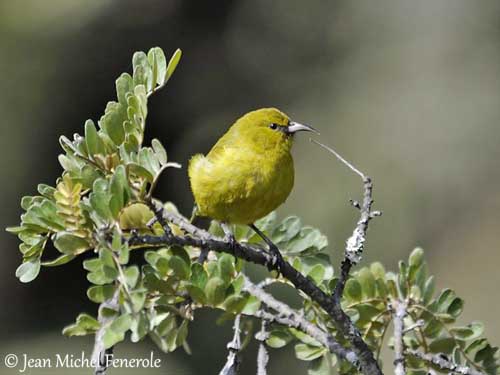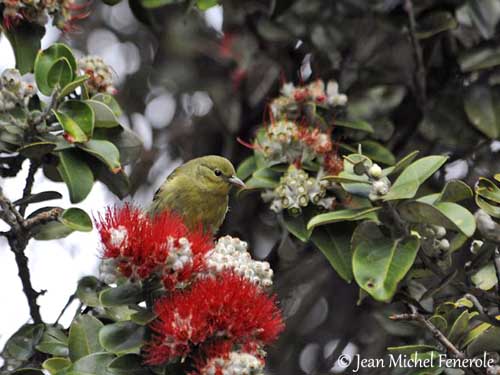
The female lays 1-4 creamy-white eggs with darker markings. She incubates during 14 days. The chicks are fed by both parents by regurgitation. The nest is variably cleaned throughout the cycle, but fecal sacs are removed, although sometimes they accumulate on the rim of the nest. The young fledge 16 days after hatching.
PROTECTION / THREATS / STATUS:
The Hawaii Amakihi has restricted range where it is common to locally abundant. Its populations appear stable. There is a possible future reintroduction on Lanai.
This species is not currently threatened.
Fr: Amakihi familier
All : Hawaii-Amakihikleidervogel
Esp : Amakihi de Hawai
Ita: Amakihi
Nd: Amakihi
Sd: Hawaiiamakihi
Photographer:
Jean Michel Fenerole
Photos d’Oiseaux du monde
Text by Nicole Bouglouan
Sources:
HANDBOOK OF THE BIRDS OF THE WORLD Vol 15 by Josep del Hoyo-Andrew Elliot-David Christie - Lynx Edicions – ISBN: 9788496553682
BirdLife International (BirdLife International)
Wikipedia, la enciclopedia libre
What Bird-The ultimate Bird Guide (Mitchell Waite)
Maui Forest Bird Recovery Project
Hawaii Amakihi
Hemignathus virens
Passeriformes Order – Fringillidae Family
INTRODUCTION:
Formerly included in the genus Chlorodrepanis with two other Amakihis, the Hawaii Amakihi is now in the genus Hemignathus.
These three species were limped into a single species, but morphological and behavioural differences, added to DNA evidence, involve their recognition as full species.
They have short, strongly down-curved bills, fairly thick at base and tapering to a sharp tip.
The birds displayed on this page are the subspecies “wilsoni” seen on Maui, except the 4th one which is "virens"from Hawaii.
DESCRIPTION OF THE BIRD:
Biometrics:
Length: 11 cm
Weight: 10,5 - 16 g
The adult male of the nominate race “virens” has yellowish to olive-green plumage overall, with paler face and underparts, with indistinct boundaries. Wings and tail feathers are dark brownish-grey with olive-green edges.
The short, down-curved bill is brown to black, with pale blue base. The eyes are very dark, almost black. Lores are black too. Legs and feet are dark grey.

The female has similar plumage but duller. She has shorter bill, mostly greenish.
The juvenile has dull grey-green upperparts and duller underparts, sometimes with yellow streaks. Lores are grey. The upperwing shows two pale wingbars.
SUBSPECIES AND RANGE:
We can find two subspecies:
H.v. virens (here described) is found on Hawaii Island, in E Hawaiian Islands.
H.v. wilsoni is found on Molokai and Maui. This one is very similar to nominate, with the male slightly paler below. The female is greyer than male.
HABITAT:
The Hawaii Amakihi can be found in all forest types, but it prefers drier and more open forests. They are more numerous in drier forests on Hawaii, and they reach highest densities in wet forest on Maui.
On both islands, the species can be seen in subalpine brush above the tree-line, up to 2400 metres of elevation.
CALLS AND SONGS: SOUNDS BY XENO-CANTO
The Hawaii Amakihi’s calls include a buzzy “tzeet”, short chirps, and a rising whistle or squeak “quee-ee”.
The song is a loud trill swelling in pitch. It also gives a complex, whisper song.

BEHAVIOUR IN THE WILD:
The Hawaii Amakihi feeds mainly on nectar from various flowers such as ohia-lehua (Metrosidero polymorpha), wiliwili (Rubus hawaiensis) and mamane (Sophora chrysophylla). It also takes invertebrates such as caterpillars, sucks juices from fruits and tree sap (from natural flow, but also from sap wells created by other species).
It gleans invertebrates from bark and foliage. Nectar is taken from both native and introduced flowers. It uses its tubular tongue to drink the nectar. It hunts for spiders and insects in trees and shrubs.
The Hawaii Amakihi has monogamous breeding system, and mates often remain together for several years. Some displays are reported such as chasing flights, hopping from branch to branch, and flitting displays. This behaviour is accompanied by the whisper song.
The Hawaii Amakihi is resident in its range. However, movements are performed according to the peaks of blossoming.
The flight is mainly direct in forest canopy, but mostly undulating over longer distances.

REPRODUCTION OF THIS SPECIES:
The breeding season is extended and nests can be found all year round.
The female builds the nest, an open cup made with various materials such as twigs, grass stems and leaves. The outside of the cup is fairly coarse, but the inner cup is lined with softer materials, and mainly plant fibres. This structure is placed in terminal or lateral fork in dominant tree over the area.
The pair defends a larger territory than other species.
